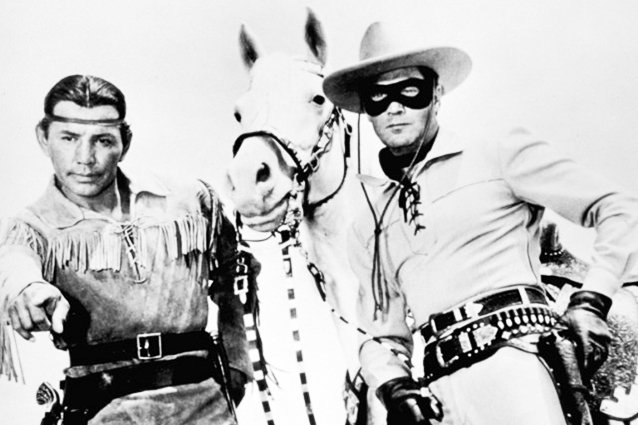
ABC
So after Disney invested nearly $250 million — and a whole lot of franchise hopes — into it, The Lone Ranger
is likely going to be just that: a one-off, underperforming misfire
instead of the springboard for an enduring movie series. There are a lot
of reasons why the Johnny Depp-Armie Hammer
actioner fizzled. Did the much-coveted teen male demographic have any
built-in interest in a property that's best known as a TV series that
debuted in 1949? Probably not. But oddly enough, if director Gore
Verbinski and producer Jerry Bruckheimer had followed the template set
by that TV series, starring Clayton Moore as the masked avenger and Jay
Silverheels as his Native American companion Tonto, they might have made
a more successful movie. Here are six reasons why the 64-year-old TV
series is better than the new film.1. The Lone Ranger and Tonto Really Are Equals
People think that Silverheels' Tonto is just a sidekick in the original series. But from the very beginning he was the Lone Ranger's true partner. They were equally competent and enhanced each other's strengths, offering up an ideal of Anglo-Native American cooperation and harmony that obviously never happened but is a utopian vision worth striving for — especially considering the tendency of many other Westerns of the time to glorify the genocide of the Native Americans. But for that vision to ring true, the Lone Ranger can't be a bland doofus, the way he is in Verbinski's film. He can't be dragged through horse manure. The mere fact that Depp is credited above the title, before Hammer, shows that the Lone Ranger isn't even as important as Tonto in this take on the characters.
2. The Pilot Gets Right Into the Drama
Verbinski's film offers up a framing device in which the story of the Lone Ranger is being retold by an ancient Tonto in 1933. But the pilot episode of the original series, "Enter the Lone Ranger," gets right into the drama. Six Texas Rangers are led into a canyon where they're massacred by Butch Cavendish's gang — within the first five minutes of the plot.
3. It Doesn't Linger Over Personal Revenge
One man, John Reid, survives and crawls away to safety before being rescued by Tonto, just as Reid had saved Tonto many years ago. We learn later that his brother was one of the Rangers gunned down alongside him, but the "This Time...It's Personal" dynamic of Reid's journey toward becoming the Lone Ranger in the movie, doesn't exist in the show. Cavendish is evil, but not the kind of guy who actually eats the heart of Reid's brother. The idea of fighting for justice, to bring order out of chaos, was satisfying enough.
4. ...But It Doesn't Skimp on the Brutality
When the posse of Texas Rangers are gunned down in the pilot episode, Cavendish's men inspect each one, kicking over their cold corpses with their boots then leaving them out in the sun without any proper burial. Cavendish even shoots Collins, the man who helped lead the Rangers into the trap, in the back, to get rid of him as a witness. This is the archetypal template for much of today's superheroes: a tragedy-scarred survivor haunted by his past fights for a world in which such chaos isn't possible. But in the movie, the brutality against the Rangers isn't as ruthlessly mechanical, it's cartoonishly over the top (again, the eating of the heart). And when the cavalry are massacring the Comanches, senseless slaughter is glossed over by the Lone Ranger and Tonto's gallivanting around. The violence is more extreme, yet somehow less consequential.
5. There Isn't a Supernatural Element
In the movie, Reid is actually brought back from the dead by a "spirit walker," according to Tonto, meaning that he can't be killed in battle. But in the TV show, he's really just nursed back to health. He didn't need to have supernatural ability or blessing to be formidable, only his convictions.
6. The Lone Ranger Was Vulnerable
Fran Striker, who created the Lone Ranger for radio in 1933, decreed that his adventures always had to be realistic. The Ranger couldn't win against impossible odds or flee a hail of bullets by riding toward the horizon. That mantra applied to the TV show as well, meaning that the Ranger never found himself in the kind of over-the-top set pieces that are in the movie. It was attainable heroism. He could bleed, he could nearly be killed, but you believed you could be him. That's not a fantasy Verbinski's film offers its audience.
For a taste of what this great Western mythos was originally like, check out the pilot episode of The Lone Ranger TV series from Sept. 15, 1949 below.
No comments:
Post a Comment